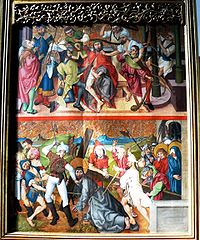
Bas-Rhin is a département in Alsace which is a part of the Grand Est super-region of France. The name means 'Lower Rhine', referring to its lower altitude among the two French Rhine departments: it is downstream of the Haut-Rhin department. Both belong to the European Upper Rhine region. It is, with the Haut-Rhin, one of the two departments of the traditional Alsace region which until 1871, also included the area now known as the Territoire de Belfort. The more populous and densely populated of the pair, it had 1,152,662 inhabitants in 2021. The prefecture is based in Strasbourg. The INSEE and Post Code is 67.

Haut-Rhin is a département in the Grand Est region, France, bordering both Germany and Switzerland. It is named after the river Rhine. Its name means Upper Rhine. Haut-Rhin is the smaller and less populated of the two departments of the former administrative Alsace region, the other being the Bas-Rhin. Especially after the 1871 cession of the southern territory known since 1922 as Territoire de Belfort, although it is still rather densely populated compared to the rest of metropolitan France. It had a population of 767,083 in 2021.
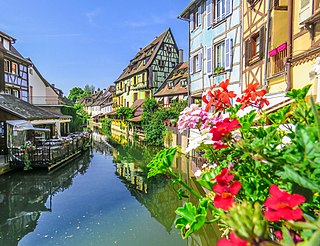
Colmar is a city and commune in the Haut-Rhin department and Alsace region of north-eastern France. The third-largest commune in Alsace, it is the seat of the prefecture of the Haut-Rhin department and of the subprefecture of the Colmar-Ribeauvillé arrondissement.

Rimbach-près-Masevaux is a commune in the Haut-Rhin department in Grand Est in north-eastern France.

Sélestat is a commune in the Grand Est region of France. An administrative division (sous-préfecture) of the Bas-Rhin department, the town lies on the Ill river, 17 kilometres (11 mi) from the Rhine and the German border. Sélestat is located between the largest communes of Alsace, Strasbourg and Mulhouse.

Hombourg-Haut is a commune located in the department of Moselle, region of Grand Est, in the cultural and historical region Lorraine, north-eastern France.
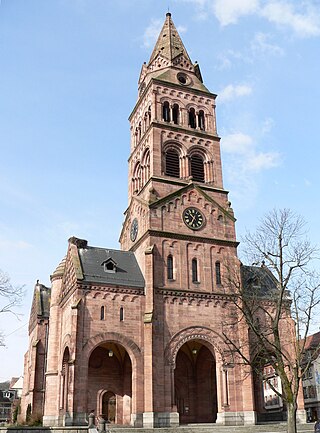
Munster is a commune in the Haut-Rhin department in Grand Est in north-eastern France. It is located in the valley of the river Fecht, in the Vosges mountains about 15 kilometres west of Colmar on the D417 road to the Col de la Schlucht and Épinal.
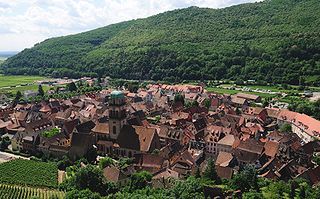
Kaysersberg is a historical town and former commune in Alsace in northeastern France. The name is German for Emperor's Mountain. The high fortress that dominates the town serves as a reminder of both its strategic importance and its warlike past.

The Unterlinden Museum is located in Colmar, in the Alsace region of France. The museum, housed in a 13th-century Dominican religious sisters' convent and a 1906 former public baths building, is home to the Isenheim Altarpiece by the German Renaissance painter Matthias Grünewald and features a large collection of local and international artworks and manufactured artifacts from prehistorical to contemporary times. It is a Musée de France. With roughly 200,000 visitors per year, the museum is the most visited in Alsace.

Lièpvre is a commune in the Haut-Rhin department in Grand Est in north-eastern France. A monastery was built here in the eighth century by Saint Fulrad, who filled it with relics of Saint Cucuphas and Saint Alexander.

Soultz-Haut-Rhin is a commune in the Haut-Rhin département in Grand Est in north-eastern France.

Rouffach is a commune in the Haut-Rhin department in Grand Est in north-eastern France.
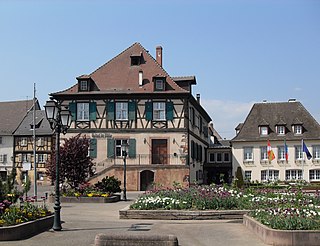
Wintzenheim is a commune in the Haut-Rhin département in Grand Est in north-eastern France.

Ottrott is a commune in the Bas-Rhin department in Grand Est in north-eastern France. It lies southwest of Strasbourg. The vineyards in and around Ottrott produce the red Rouge d'Ottrott, a geographical denomination within the registered designation of origin Alsace AOC.

Thannenkirch is a commune and tourist destination in the northeastern French department of Haut-Rhin.

Wasserbourg is a commune in the Haut-Rhin department in Grand Est in north-eastern France.

The Château du Hugstein is a ruined castle on the borders of the communes of Buhl and Guebwiller in the Haut-Rhin département of France.

The arrondissement of Thann-Guebwiller is an arrondissement of France in the Haut-Rhin department in the Grand Est region. It has 81 communes. Its population is 130,270 (2016), and its area is 907.1 km2 (350.2 sq mi).

Longny les Villages is a commune in the department of Orne, northwestern France. The municipality was established on 1 January 2016 by merger of the former communes of La Lande-sur-Eure, Longny-au-Perche, Malétable, Marchainville, Monceaux-au-Perche, Moulicent, Neuilly-sur-Eure and Saint-Victor-de-Réno. Its seat, Longny-au-Perche, is classed as a Petites Cités de Caractère.

The Buhl Altarpiece is a late 15th-century, Gothic altarpiece of colossal dimensions now kept in the parish church Église Saint-Jean-Baptiste of Buhl in the Haut-Rhin département of France. It was painted by followers of Martin Schongauer, most probably for the convent of the Dominican sisters of Saint Catherine of Colmar, and moved to its present location in the early 19th century. It is classified as a Monument historique by the French Ministry of Culture.






